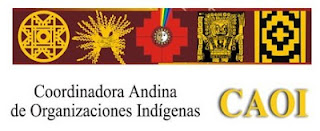Guarantees for the respect, protection and promotion of traditional knowledge and sustainable ways of life of indigenous peoples, and that all mitigation and adaptation actions incorporate these components, are some of the approaches of Andean indigenous peoples in the face of climate change.
Proposals from indigenous peoples regarding climate change
We, the Andean indigenous peoples, are those who have inhabited our Andean territories since long before the European invasion of Abya Yala (the American continent) and the formation of the current republics. Our way of life remains in force because we knew and know how to adapt to the climates of the Andean mountains. We have preserved our knowledge of nature, but today we face the effects of climate change. These impacts affect our ways of life, because we depend on our territories and the natural resources they contain for our survival. Climate change causes disasters (such as intense rains and droughts in the highlands, which make us increasingly vulnerable), modifies the ecological systems of the mountains and, over time, will cause the disappearance of Andean biodiversity.
Faced with this situation, the Andean Coordinator of Indigenous Organizations proposes:
- General framework:
- Recognize and respect the self-determination of indigenous peoples, particularly our rights to territories and natural resources, in accordance with the UN Declaration on the Rights of Indigenous Peoples.
- Full and effective participation of indigenous peoples at all levels, respecting processes based on consultation and prior, free and informed consent.
- Recognize, respect and strengthen the fundamental contribution of traditional knowledge, innovations and practices of indigenous peoples.
- Review the concepts of development based on the accumulation of wealth that emphasize the unlimited exploitation of natural resources.
- Shared vision:
- Adopt concrete frameworks for reducing greenhouse gas (GHG) emissions as a follow-up to the Kyoto Protocol, whose first commitment period expires this year.
- A reduction in emissions of at least 451 TP3T below 1990 levels by 2020 and at least 951 TP3T by 2050.
- Financial, technological, adaptation, capacity-building, production and consumption patterns measures, and other essential measures such as the recognition of the rights of Mother Earth to reestablish harmony with nature.
- Transfer of technology:
- Knowledge is universal and cannot be owned or used by private parties, nor can its applications in the form of technology. Developed countries must share their technology with developing countries.
- The transfer and installation of technologies must be immediate, timely, free of cost, in harmony with Mother Earth and without conditionalities.
- The intellectual property rights regime must be modified to ensure access to clean mitigation and adaptation technologies, with the participation of public funds. It must include disclosure of the source of ancestral knowledge, prior informed consent and equitable sharing of benefits.
- Establish a multilateral and multidisciplinary mechanism for participatory control, management and continuous evaluation of technology exchange. These technologies must be useful, clean and socially appropriate.
- Establish a financing fund and inventory of appropriate technologies free of intellectual property rights, particularly patents that must pass from private monopolies to being in the public domain, freely accessible and at low cost.
- Incorporate indigenous peoples' knowledge and technologies and ensure the participation of indigenous experts.
- Adaptation and mitigation:
- Ensure respect for, protection of and promotion of traditional knowledge and sustainable livelihoods of indigenous peoples. Include environmental and social safeguards for indigenous peoples, including cultural and spiritual aspects.
- Policies and public funds that prioritize the comprehensive territorial recognition of indigenous peoples. Recognize and promote indigenous peoples' own systems for the use, management and conservation of natural resources.
- Any mitigation and adaptation action must incorporate the knowledge and technologies of indigenous peoples, subject to their free, prior and informed consent, while ensuring the participation of indigenous experts.
- Financing:
- Any financing mechanism for climate change mitigation and adaptation must be established under the United Nations Framework Convention on Climate Change and direct resources must be provided to indigenous peoples.
- Establish participatory mechanisms to ensure transparency and accountability in all financing procedures and operations. Resources must come from public sources and be additional to development aid funds.
- Establish a special fund to enable indigenous peoples and local communities to develop their own activities and contributions to address climate change.
- Developed countries must commit at least 61 TP3 T of their gross domestic product to address climate change in developing countries in new annual financing.
- Funding must be direct, unconditional and not violate national sovereignty or the self-determination of the most affected communities and groups.
- International financial institutions, such as the World Bank, should be excluded from the administration of funds created and to be created.
- Carbon markets and related mechanisms:
- Abandon false solutions to climate change that negatively impact our rights: nuclear power, massive hydroelectric dams, geoengineering techniques, “clean coal,” agrofuels, plantations, carbon market mechanisms, Clean Development Mechanisms and forest offsets.
- Market-based solutions, both those related to the Clean Development Mechanism and REDD+ proposals, constitute new forms of economic geopolitics that threaten indigenous rights guaranteed in multiple international instruments and the livelihoods of our peoples.
- REDD+ must guarantee and respect the rights of indigenous peoples, traditional ways of life and customary forest governance.
![]()

